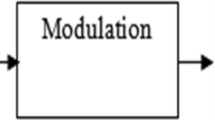Abstract
In order to scale with the demand of higher data rates and improved spectral efficiency in next generation wireless communication systems, a large-scale multiple-input and multiple-output (MIMO) technology called massive MIMO has been proposed. In massive MIMO, appropriate signal-to-noise ratio (SNR) values can be achieved by the addition of base station (BS) antennas in place of increasing transmit power. Pilot-based channel estimation is widely used in conventional MIMO systems, where pilot signal sequences are sent from the user terminals (UTs) to the BS to estimate the channel. In massive MIMO-based cellular networks, channel estimation in a given cell will be impaired by the pilot signal sequences transmitted by users in other cells—rendering the addition of antennas or transmit power ineffective. This effect is called pilot contamination. Therefore, pilot-based channel estimation limits the performance of massive MIMO. Semi-blind and blind methods are alternatives to pilot-based channel estimation that perform channel estimation with short pilot signal sequences and without pilot signal sequences, respectively. Blind channel estimation is one of the promising solutions to the pilot contamination problem in massive MIMO. This paper compares, using MATLAB simulations of a cluster-based COST 2100 channel model, the performance of pilot-based, semi-blind, blind, and adaptive-blind channel estimation methods. The pilot contamination effect on different channel estimation methods and how channel estimation methods can be used to overcome pilot contamination are shown. Finally, an adaptive independent component analysis (ICA)-based channel estimation method, which outperforms conventional ICA in terms of computational complexity, is proposed.






Similar content being viewed by others
References
Li, Q., Li, G., Lee, W., il Lee, M., Mazzarese, D., Clerckx, B., et al. (2010). MIMO techniques in WiMAX and LTE: A feature overview. IEEE Communications Magazine, 48(5), 86–92.
Larsson, E., Edfors, O., Tufvesson, F., & Marzetta, T. (2014). Massive MIMO for next generation wireless systems. IEEE Communications Magazine, 52(2), 186–195.
Elijah, O., Leow, C., Rahman, T., Nunoo, S., & Iliya, S. (2015). A comprehensive survey of pilot contamination in massive MIMO—5G system. IEEE Communications Surveys Tutorials, 99, 1–1.
Hyvarinen, A. (1999). Fast and robust fixed-point algorithms for independent component analysis. IEEE Transactions on Neural Networks, 10(3), 626–634.
Lu, L., Li, G., Swindlehurst, A., Ashikhmin, A., & Zhang, R. (2014). An overview of massive MIMO: Benefits and challenges. IEEE Journal of Selected Topics in Signal Processing, 8(5), 742–758.
Hijazi, H., Simon, E., Lienard, M., & Ros, L. (2010). Channel estimation for MIMO-OFDM systems in fast time-varying environments. In Communications, Control and Signal Processing (ISCCSP), 2010 4th International Symposium on, pp. 1–6.
Sharma,V., & Kumar, S. (2010). Recent developments in MIMO channel estimation techniques. In Digital Information and Communication Technology and it’s Applications (DICTAP), 2012 Second International Conference on, pp. 1–6.
Li, Q., Georghiades, C. N., & Wang, X. (2004). Blind multiuser detection in uplink cdma with multipath fading: A sequential em approach. IEEE Transactions on Communications, 52(1), 71–81.
Schmidt, R. (1986). Multiple emitter location and signal parameter estimation. IEEE Transactions on Antennas and Propagation, 34(3), 276–280.
Roy, R., & Kailath, T. (1989). Esprit-estimation of signal parameters via rotational invariance techniques. IEEE Transactions on Acoustics, Speech, and Signal Processing, 37(7), 984–995.
Sanzi, F., & Necker, M. C. (2003). Totally blind app channel estimation with higher order modulation schemes. In Vehicular Technology Conference, 2003. VTC 2003-Fall. 2003 IEEE 58th, vol. 2, pp. 1167–1171 Vol. 2.
Cao, L., Chen, C. W., Orlik, P., Zhang, J., & Gu, D. (2002). Blind channel estimation and equalization using viterbi algorithms. In Vehicular Technology Conference, 2002. VTC Spring 2002. IEEE 55th, vol. 3, pp. 1532–1535 vol. 3.
Shiratsuchi, H., Iwasaki, N., Tanaka, H., Ishibashi, T., Haratani, N., Nakano, Y., & Gotanda, H. (2010). Blind carrier frequency offset and channel estimation using ica in qam-ofdm systems. In TENCON 2010—2010 IEEE Region 10 Conference, pp. 1330–1335.
Ngo, H. Q., & Larsson, E. (2012). EVD-based channel estimation in multicell multiuser MIMO systems with very large antenna arrays. In Acoustics, Speech and Signal Processing (ICASSP), 2012 IEEE International Conference on, pp. 3249–3252.
Hu, A., Lv, T., & Lu, Y. (2013). Subspace-based semi-blind channel estimation for large-scale multi-cell multiuser MIMO systems. In Vehicular Technology Conference (VTC Spring), 2013 IEEE 77th, pp. 1–5.
Radenkovic, M., Bose, T., & Ramkumar, B. (2010). Blind adaptive equalization of MIMO systems: New recursive algorithms and convergence analysis. IEEE Transactions on Circuits and Systems I: Regular Papers, 57(7), 1475–1488.
Rappaport, T. S. (1996). Wireless Communications. Englewood Cliffs, NJ: Prentice-Hall.
Müller, R. R., Cottatellucci, L., & Vehkaperä, M. (2014). Blind pilot decontamination. IEEE Journal on Selected Topics in Signal Processing, 8(5), 773–786.
Liu, L., Oestges, C., Poutanen, J., Haneda, K., Vainikainen, P., Quitin, F., et al. (2012). The COST 2100 MIMO channel model. IEEE Wireless Communications, 19(6), 92–99.
Bagadi, K. P., & Das, P. S. (2010). MIMO-OFDM channel estimation using pilot carries. International Journal of Computer Applications 2(3), 81–88, published By Foundation of Computer Science.
Sawada, H., Mukai, R., Araki, S., & Makino, S. (2004). A robust and precise method for solving the permutation problem of frequency-domain blind source separation. IEEE Transactions on Speech and Audio Processing, 12(5), 530–538.
Author information
Authors and Affiliations
Corresponding author
Rights and permissions
About this article
Cite this article
Peken, T., Vanhoy, G. & Bose, T. Blind channel estimation for massive MIMO. Analog Integr Circ Sig Process 91, 257–266 (2017). https://doi.org/10.1007/s10470-017-0943-1
Received:
Revised:
Accepted:
Published:
Issue Date:
DOI: https://doi.org/10.1007/s10470-017-0943-1




